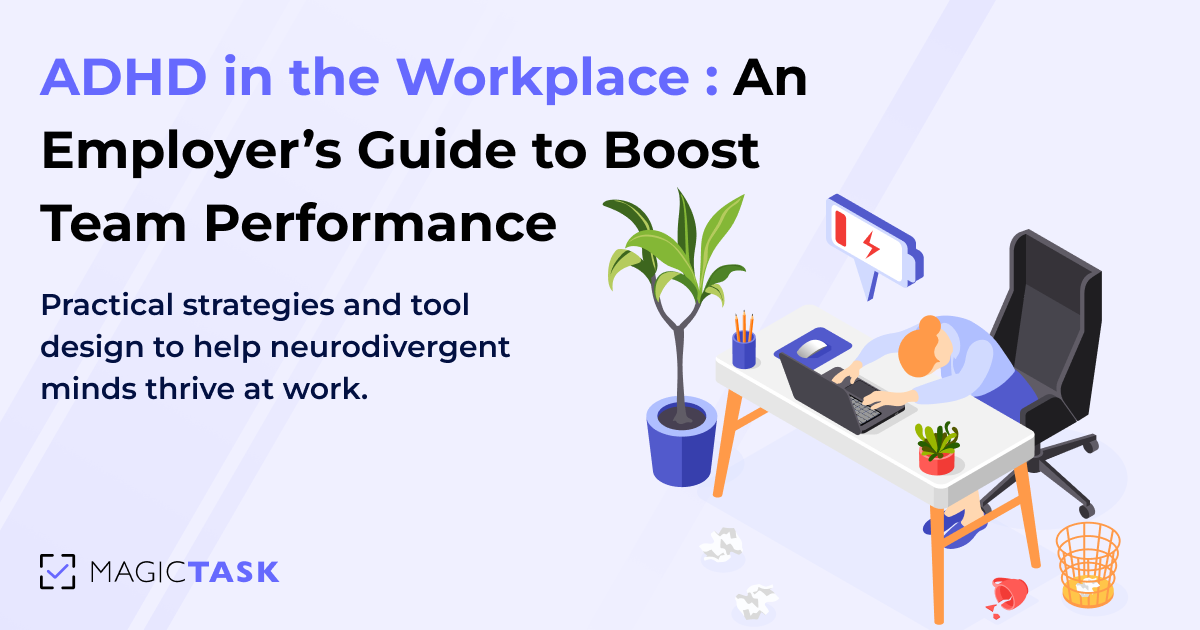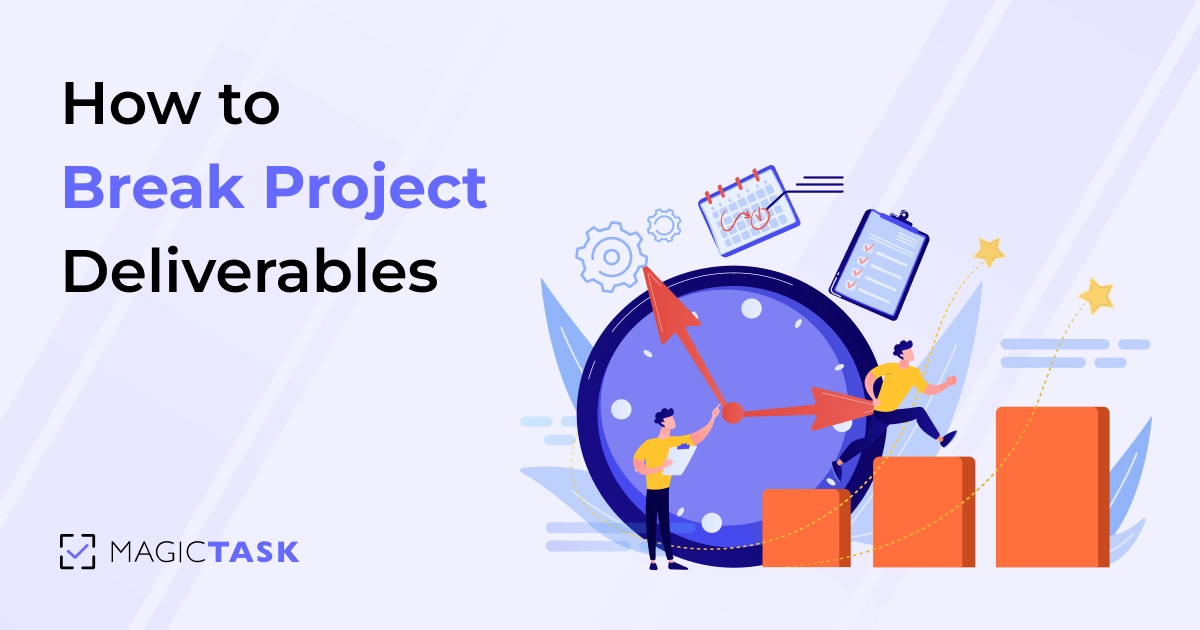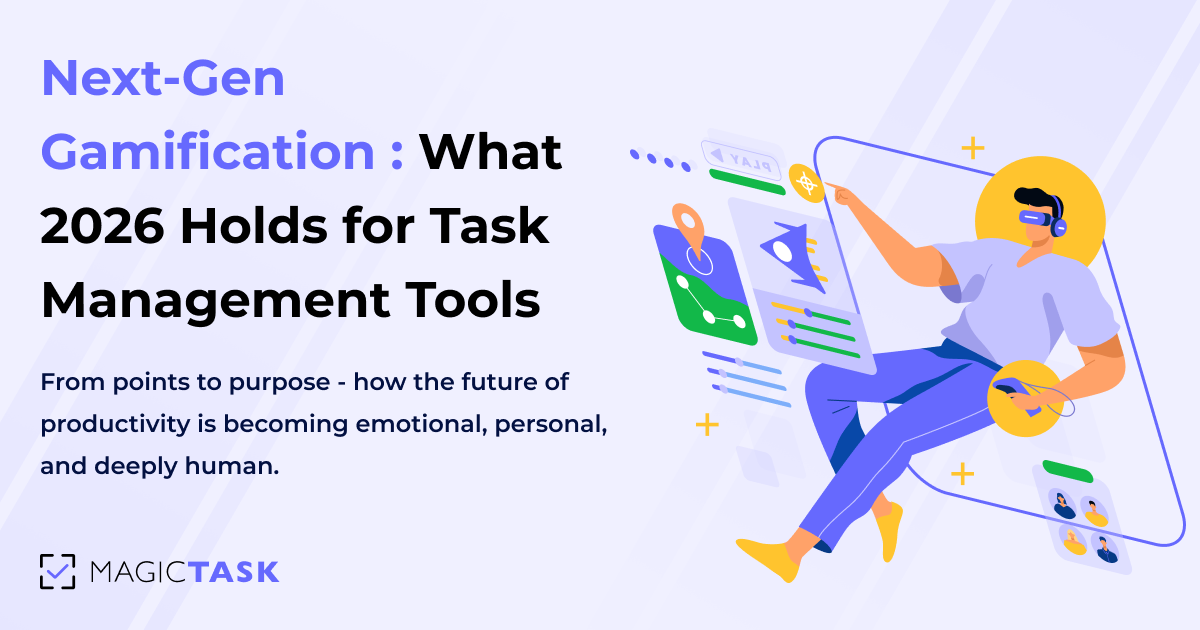Ivy Lee Method: A Simple Routine to Stay Productive Every Day
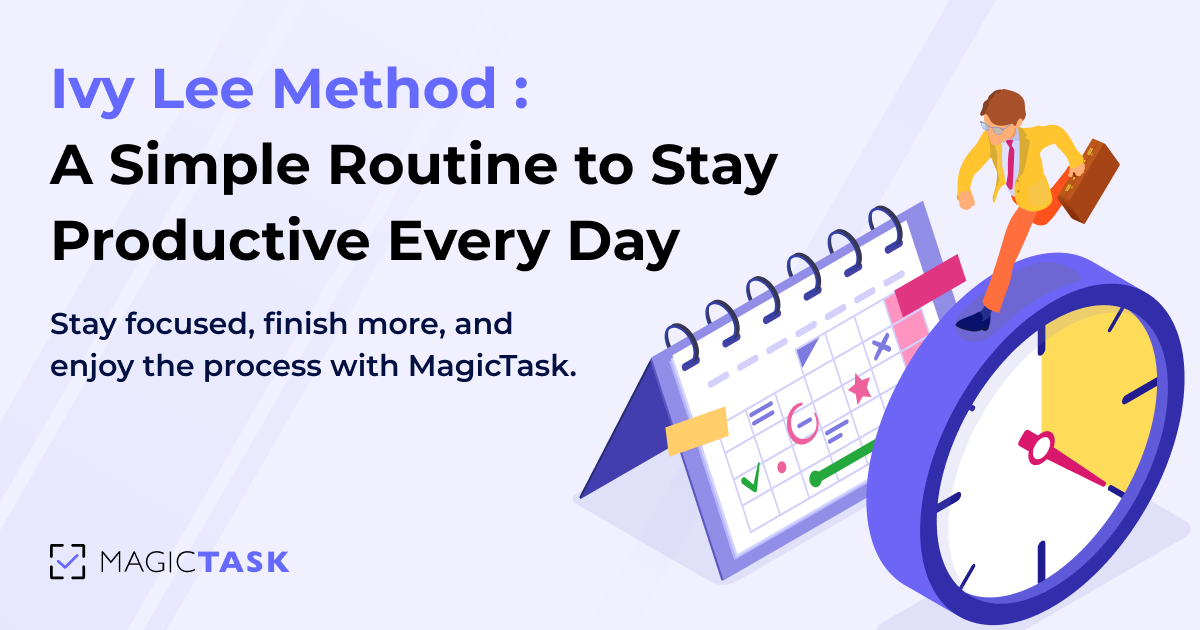
Most professionals end the day with more tasks than they started with. To-do lists sprawl, priorities blur, and the sense of progress slips away in the noise of digital tools.
Over 100 years ago, an executive coach named Ivy Lee gave business leaders a deceptively simple solution, one that still works today. It was a 6-task system designed to bring focus, momentum, and clarity into every workday.
The method is so timeless, it still shows up in leadership circles, productivity books, and team playbooks. But that method used pen and paper, something that won’t be so effective in today’s digital world.
That’s where MagicTask comes in. It combines the elegance of the Ivy Lee Method with a modern, gamified system that makes it easy to stick to and even enjoyable.
Let’s break down how it works, where traditional routines fall short, and how you can use MagicTask to bring the Ivy Lee Method to life in 2025.
What Is the Ivy Lee Method?
The Ivy Lee Method is one of the simplest and most enduring productivity techniques still in use, and it dates back to 1918.
It began when Charles M. Schwab, then-president of Bethlehem Steel, asked productivity consultant Ivy Lee for advice on improving his team’s efficiency. Lee gave Schwab a 15-minute coaching session and a single instruction: at the end of each workday, have your executives write down the six most important tasks they needed to complete the next day, and then rank them in order of priority.
Lee's advice was as follows:
- Write down six (and only six) tasks for tomorrow.
- Rank them in order of true importance.
- Start with task #1 the next day and work your way down — no multitasking.
- Move any unfinished tasks to the next day’s list.
After a few weeks of using the system, Schwab was so impressed by the results that he reportedly sent Lee a check for $25,000, the equivalent of over $500,000 today.
It worked then because it was simple, focused, and easy to repeat. And over 100 years later, that clarity still cuts through the noise.
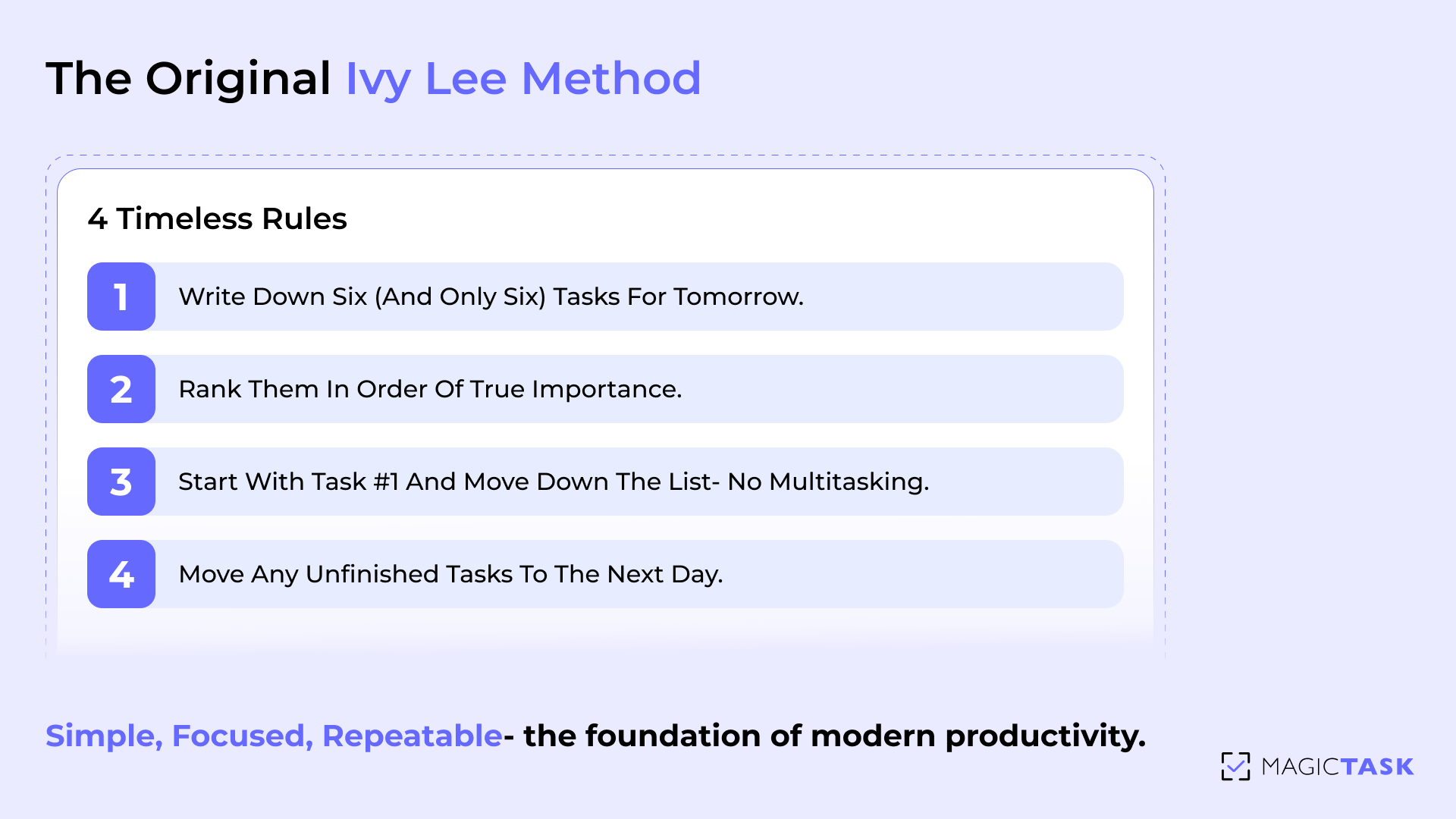
Why It Falls Short Today
The Ivy Lee Method was built for a world with fewer interruptions, slower communication, and static priorities. In 1918, six handwritten tasks could carry you through an entire day without much change. Today’s work reality looks very different.
1. Multiple Tasks Compete for Attention
The Ivy Lee Method assumes a linear workday, one where you can calmly move through six prioritized tasks in sequence. But modern workflows rarely operate like that. You’re pulled into meetings, asked to review something “quickly,” or hit with last-minute fire drills. Suddenly, your #2 tasks get bumped by five unplanned requests.
Even worse, most professionals today don’t have just six tasks — they have dozens, scattered across emails, chat apps, project dashboards, and sticky notes. Picking six feels impossible when everything feels urgent.
This overload leads to:
- Decision fatigue about what deserves to make the list.
- Missed priorities as reactive tasks take over.
- Mental stress from knowing there’s more than six items waiting in the background.
Without a flexible, visible system, the Ivy Lee Method can feel like a nice idea that collapses under the weight of modern work chaos.
2. Digital Distractions Disrupt the Flow
When the Ivy Lee Method was created in 1918, there were no Slack messages, calendar pings, or app notifications pulling your focus every five minutes. Today, most professionals operate in environments saturated with digital noise. Every time your phone buzzes or your browser flashes a new tab, your focus breaks, and with it, the flow you need to work through a prioritized list.
Even if you start your day with a clear list, staying on task is another challenge entirely.
Common digital distractions include:
- Incoming emails that feel urgent (but rarely are)
- Chat notifications from teammates
- Calendar events breaking up your work blocks
- Temptation to check social media or refresh dashboards
These distractions fragment your attention and weaken your ability to move through tasks with intention. Without a system that reinforces focus and rewards progress, even the best list can become background noise.
3. Team Visibility & Shifting Priorities
The Ivy Lee Method works best in a world where your priorities stay stable from one day to the next. But in modern team environments, priorities can change by lunchtime, and without real-time visibility, your carefully ranked list can quickly become outdated.
When tasks are planned on paper or in a private system, teams face two major problems:
- No shared visibility: Teammates can’t see what you’re working on or where they can support you.
- Lack of alignment: Project priorities shift, but your to-do list doesn’t — causing delays, missed expectations, and duplicated work.
In fast-moving teams, static systems don’t reflect dynamic reality. Without a way to re-prioritize collaboratively or adjust based on shared goals, even a focused method like Ivy Lee starts to break down.
That’s why a modern task system needs to bridge personal focus with team visibility. In the next section, you’ll see how MagicTask does exactly that — adding the flexibility, transparency, and motivation the Ivy Lee Method needs to thrive in 2025.
How MagicTask Supercharges Ivy Lee
MagicTask brings structure, visibility, and motivation to the classic six-task routine. Instead of relying on pen and paper or hoping you'll remember to reprioritize throughout the day, MagicTask gives you a digital flow that makes this method sustainable.

1. Mind Dump: Clear Your Mental Cache
The first step in modernizing the Ivy Lee Method with MagicTask is a full mind dump, getting every task, idea, or loose end out of your head and into a trusted system.
Mental clutter drains your focus. Studies show that people spend nearly 47% of their waking hours thinking about something other than what they’re doing, while physical and mental clutter split their attention, making it harder to concentrate. If your brain is juggling reminders, priorities, and half-finished thoughts, productivity suffers.
MagicTask turns the mind dump into a frictionless habit:
- Tap into the “Add Task” flow and unload everything — work, personal, urgent, unclear.
- Don’t worry about structure yet. Just get it out.
- Use voice or keyboard, whichever feels faster in the moment.
Once your mental cache is cleared, you’re ready to bring focus back to what really matters — your priorities for the day.
2. Task Sizing for Realistic Planning
One of the biggest reasons the Ivy Lee Method can fall apart in modern workflows is that not all tasks are created equal. Writing down six things without understanding their complexity leads to burnout, skipped tasks, or an unrealistic day plan.
That’s where MagicTask’s task sizing system adds depth without adding friction.
MagicTask uses a simple sizing system — S, M, L, XL — to help you gauge how much time and focus each task demands. Here’s how that typically looks:
| Task Size | Effort Level | Time Needed | Examples |
|---|---|---|---|
| S | Quick, no setup | Under 10 minutes | Reply to email, set calendar reminder |
| M | Moderate, focused | 20–30 minutes | Draft client update, run report |
| L | Deep work | 45–60 minutes | Write article, prep presentation |
| XL | High effort / multi-step | 90+ minutes | Build proposal, fix bugs, onboard hire |
When you’re using the Ivy Lee Method inside MagicTask, sizing your tasks gives you clarity on:
- How many you can realistically complete
- Where to place deep work
- Which tasks might need to be split or deferred
It’s about finishing what matters without overcommitting. Task sizing keeps your list honest.
3. Drag-and-drop Reprioritization
Reprioritization is inevitable in modern work. While the Ivy Lee Method encourages a clear starting point, it assumes that priorities remain static from morning to evening, but real life doesn’t work that way. Clients call. Urgencies change. Your energy dips mid-afternoon. And suddenly, your sixth task needs to become your first.
With MagicTask, you don’t have to abandon the method — you just make it fluid. The drag-and-drop functionality lets you instantly reorder your daily six as new information comes in. There’s no rewriting, no breaking focus, no need to open a different tool.
You stay anchored to your plan, but now you have the freedom to pivot when it matters. That flexibility turns a rigid method into a living system, one that moves with your day instead of resisting it.
Gamification Keeps the Routine Engaging
The Ivy Lee Method is simple — but simplicity alone doesn’t guarantee consistency. In traditional setups like pen and paper or basic task lists, the initial motivation fades quickly. MagicTask injects staying power into the method by gamifying the routine, turning task completion into a rewarding experience instead of a mental chore.
Here’s how it works, and why it makes such a difference:
- Visual Progress That Feels Good: Every completed task earns experience points (XP), contributing to visible progress within your MagicTask theme. This visual feedback loop taps into your brain’s reward system, turning small wins into satisfying momentum.
- Leveling System That Encourages Consistency: As you plan daily, complete tasks, and maintain the routine, you level up. This adds a sense of personal growth beyond just “checking boxes.” It transforms productivity into a game, one you want to keep playing.
- Theme Unlocks That Keep Things Fresh: Hitting certain milestones unlocks new UI themes, giving your workspace a fresh look. This subtle visual evolution rewards long-term use and reduces routine fatigue, keeping the method engaging over weeks and months.
- Daily Rewards That Reinforce Habits: Simply showing up and following through becomes part of your streak with rewards for consistency. This makes you more likely to stick with your plan even on low-energy days.
- Behavioral Design That Drives Focus: MagicTask uses behavioral triggers to encourage daily use, such as nudges, visual streaks, and feedback sounds. These are reinforcements designed to strengthen your planning habit in a low-effort, high-impact way.
Instead of relying on sheer willpower to keep the Ivy Lee Method going, MagicTask builds a feedback loop that sustains you. It makes the process enjoyable, and when productivity feels good, it becomes a lifestyle, not a temporary fix.
Team Alignment & Visibility
Traditional Ivy Lee routines are built for individual focus, but modern teams need shared visibility to stay aligned. MagicTask expands the method’s solo structure into a collaborative workflow.
Once each team member sets their daily top six, others can view, comment, and coordinate around those priorities. It removes ambiguity, prevents overlap, and surfaces blockers before they cause delays.
Because tasks are sized and ordered, teammates can instantly understand someone’s workload without long check-ins or status meetings. This creates a shared rhythm across departments, one where focus is personal but direction is collective. It keeps teams moving together, not just individually.
Daily Routine Example (Ivy Lee + MagicTask)
Great systems don’t just help you plan better — they help you show up consistently. That’s where the Ivy Lee Method shines. You decide your priorities today, so tomorrow starts with clarity. And inside MagicTask, this classic method turns into a daily loop you’ll actually look forward to. Here’s how it works in practice.
Here’s how the Ivy Lee Method comes to life inside MagicTask as a repeatable, energising daily workflow:
Evening Reset → Pick and Rank Your SixEnd the day by reviewing everything in your mind dump. Choose the six tasks that matter most for tomorrow. Use task sizing (S, M, L, XL) to avoid overloading yourself, then drag them into order of priority. This closes the day with clarity and sets you up for momentum in the morning.
Morning Kickoff → Start With #1 in MagicTaskLog in and head straight to your #1 task. No overthinking, no scrolling. Just execute. The clean UI and visual structure reduce distractions, so you can get into flow right away.
During the Day → Capture New Tasks Without Losing FocusNew priorities always pop up, but don’t let them derail your focus. Drop them into your mind dump or “inbox” space, then return to your current task. You’ll process them during your next reset, not in the middle of deep work.
End of Day → Review & Carry ForwardWrap up with a quick review. Celebrate what you finished (and enjoy the gamified rewards). Any unfinished tasks? Reassess and re-rank them for tomorrow. This daily loop strengthens consistency and reduces mental fatigue.
Tips to Make It Stick
If six tasks feel overwhelming at first, start with just three. The goal is progress, not pressure. Mix in different task sizes so your day doesn’t get overloaded. Stacking multiple XL tasks often leads to frustration and burnout.
Keep your number one task visible and, when possible, share it with your teammates. This signals what you need uninterrupted focus on and helps reduce unnecessary context-switching. Small habits like these make the Ivy Lee Method easier to follow and far more sustainable over time.
Conclusion
The Ivy Lee Method has lasted over a century for one reason: it works. Its elegance lies in its simplicity, just six tasks, ranked by priority, and tackled with focus. But staying consistent with this system in today’s fast-paced, distraction-filled environment takes more than a notebook.
MagicTask modernises the method without losing its core. You still get the clarity of the original framework, but now it’s enhanced by smart features like task sizing, drag-and-drop planning, and motivating gamification that rewards your progress. It’s everything the Ivy Lee Method promised — made sustainable for modern teams and individuals.
Try setting your first six tasks in MagicTask tonight. See how good it feels to start tomorrow with clarity, focus, and a little bit of fun.
Similar Blogs
FAQS?Have questions? Look here
The Ivy Lee Method is a productivity technique from 1918 that helps you prioritize six important tasks each day to focus on what truly matters and increase efficiency.
At the end of each day, you write down six tasks for tomorrow, rank them by importance, and tackle them in order. Any unfinished tasks move to the next day’s list.
Its simplicity and focus on a small, prioritized list help cut through modern distractions and create a clear path to daily progress.
Traditional methods rely on pen and paper, which struggle with digital distractions, changing priorities, team visibility, and modern multitasking demands.
MagicTask digitizes the method with features like task sizing, drag-and-drop reprioritization, gamification, and team visibility, making it easier to stick to and enjoyable.
Task sizing categorizes tasks as S, M, L, or XL based on effort and time needed. It ensures your daily six tasks are realistic and prevents overcommitment.
Yes, MagicTask allows teams to share priorities, comment, and coordinate tasks, creating alignment while maintaining individual focus.
Start small, focus on your top tasks, use gamification and streaks for motivation, and review your progress daily to maintain consistency.
